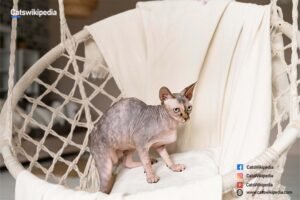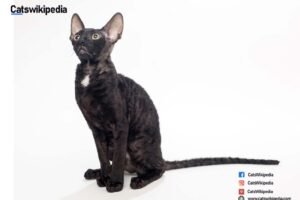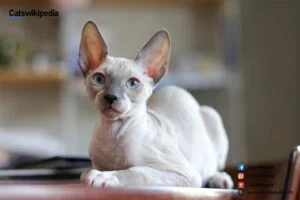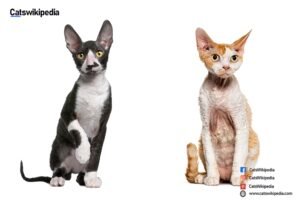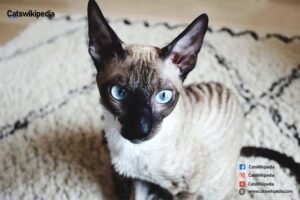CORNISH REX CATS
CORNISH REX CATS : AN INTRODUCTION
The Cornish Rex cats are a medium-sized cat of small to medium build. Until you pick her up, she appears to be a large cat because of her high stance. When viewed from the side, the underside of her body arches upward in a graceful curve that melds harmoniously with the backbone. More About the Cornish Rex.
The Cornish Rex breed is small to medium in size. Indeed, she looks big until you pick her up, for she is very tall. Her body curves upwards at the bottom, with the backbone viewed from the side.
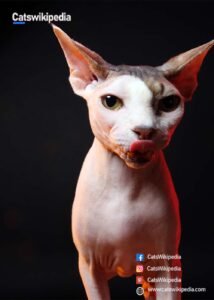
CORNISH REX TEMPERAMENT
The Cornish Rex cats are effortlessly entwines with her parents. She is one of those cats who love to be by her parents, and she will insist that time with them is part of her everyday routine. Most Cornish Rexes do just about anything to spend more time with their parents, even learning to walk on a leash. In general, they love being handled by their parents.
Athletic, this cat will maintain her correct weight if she gets enough space for exercise. The Cornish’s close-lying coat structure makes it relatively easy to see when it is becoming too heavy.
HISTORY OF CORNISH REX
The Cornish Rex cats are also a very active cat. It loves jumping and running. She cannot get enough of games. She can act like a cat with unlimited energy each time she plays. Also, she needs interactive exercises.
The first Cornish Rex kitten appeared in 1950 in Cornwall, England, due to a spontaneous breeding between a barn cat and an unknown male. Nina Ennismore, who made this fine discovery, had been a breeder of rex rabbits, so she indeed recognized something special when she saw it in this cat. She took the curly-coated cat home and named him Kallibunker, hence beginning the breed Cornish rex.
An extremely closely inbred breeding pair of Cornish rex was imported to the United States in 1957, from which all Cornish rex in the United States are descended. The breed legally entered the United States in 1967 and is now more common there than in England.
Breeders initially thought the Cornish and Devon rex curly coats were related and could be bred together. Breeding was tried, but all kittens from the breeding were straight-coated. This happened every time, so it was considered to be different breeds of curly-coated cats.
CARING FOR A CORNISH REX
Most cats have three layers of fur to help hold their body heat, Lisa Kuta, who co-founded the national Cornish Rex rescue organization Cornish Rex Friends, said — a thick outer layer of guard hairs, a middle layer of awn hairs and an inner layer that’s soft and fine, called down except not Cornish Rexes. A genetically derived mutation, they have only the down layer, which gives them the feel of cashmere, and rows of curls called a Marcel wave.
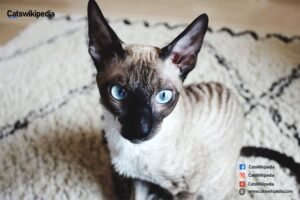
At the other end of the spectrum, Cornish Rex cats are not intended to be hypoallergenic—only low-shedding. This will be based on the fact that the protein could also be in their skin, fur, and saliva; hence, no cat should ever be said to be genuinely allergy-free. Yet all things considered, factoring in their low-shedding attribute, the Cornish Rex will turn out to be a pretty sweet deal for people with mild or even moderate allergic reactions to cats.
If you are considering bringing a Rex cat home, remember that none of the cats in the Rex cat breed family—Cornish Rex, Devon Rex, and Selkirk Rex—have any relation to the other. Lacking genetic similarity, each represents a separate breed and developed independently of the others due to separate spontaneous mutations.
In short, Cornish Rex cats are an overall healthy cat breed that lives for an average of 11 to 15 years. Few adverse health issues trouble their well-being more than other feline species. Cat insurance is something an interested parental pet may wish to look over before bringing home a Cornish Rex kitten.
PRA Stands for Progressive Retinal Atrophy
This is a hereditary Seye condition characterized by progressive retinal degeneration that leads to sight loss. Progressive retinal atrophy manifests in some forms and compromises several cat breeds, including the Cornish Rex. To date, this condition has no treatment. Cats with this condition can, on the contrary, lead normal and useful lives if regularly guided by their owner in the house.
In cats, it first manifests as night blindness between the ages of 3 and 5. The signs progress rapidly, and the cats become blind. Tests on cats for genetic markers that denote this condition will, at least, help trick the incidence of PRA in breeding stock. Those cats carrying these genetic markers should be withdrawn from breeding programs.
Hypertrophic Cardiomyopathy
It is a disease process whereby the heart walls thicken and potentially restrict the organ. It is also a bought feline heart condition and is hereditary in most cases, though it may result from high blood pressure, cancer, or even hormonal imbalance.
Most cats do not show any apparent signs, so the disease is not noticed initially. Still, with the advancement of the disease, cats may show the following signs:
- Lethargy
- Anorexia
- Emaciation.
- Dyspnoea
- Cough
- Pallor
Early diagnosis and proper treatment of HCM will significantly prolong a cat’s life.
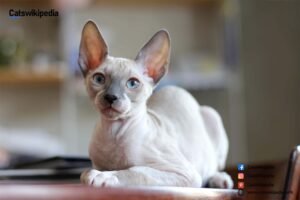
WHAT TO FEED A CORNISH REX?
Feed Commercial Cornish Rex cat food that meets the nutrient levels established by the Association of American Feed Control Officials for the specific life stage of a kitten, adult, or senior cat. Cats cannot be vegetarians. They have to eat diets that include animal byproducts, whole as meals, byproducts, or as complementary meat
CORNISH REX FAQS
1-Of what breed is the Cornish Rex cat?
As the name suggests, the Cornish Rex originates from Cornwall, England. Cornish Rex cats have big ears, thin bones, and, on average, an egg-shaped skull. The breed was brought from Cornwall, England. Devon Rex boasts of the pixie-like appearance with its “bottom-heavy” makeup, and its place of origin spans Devon, England.
Both Cornish and Devon Rex have curls in their coats but with different textures. While the Cornish Rex has only one coat compared to the Devon, which is likelier to have two layers of fur, their length is wavy and changing, something not found in the Devon. Cornish Rex are generally more social than their newer counterparts from Devon.
2-How much does a Cornish Rex cost?
Since some Cornish Rexes can cost as high as $800 to $1500, for instance, charities like Cornish Rex Friends may feature this beautiful feline for far less.
3-Are Cornish Rex Cats Affectionate?
Since Cornish Rex cats aren’t covered in fur, they are very affectionate.
4-What is Special about Cornish Rex Cat?
Of the more recognizable Cornish Rex cat characteristics, the coat, energetic attitude, and affectionate nature are probably the best known. They are also relatively bright and capable of learning many tricks.

